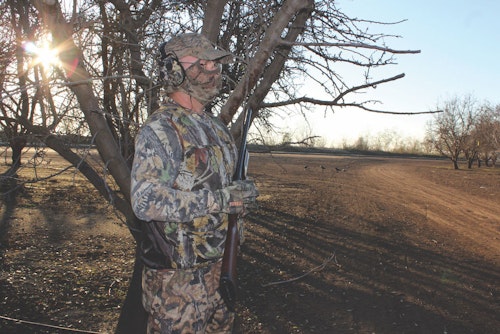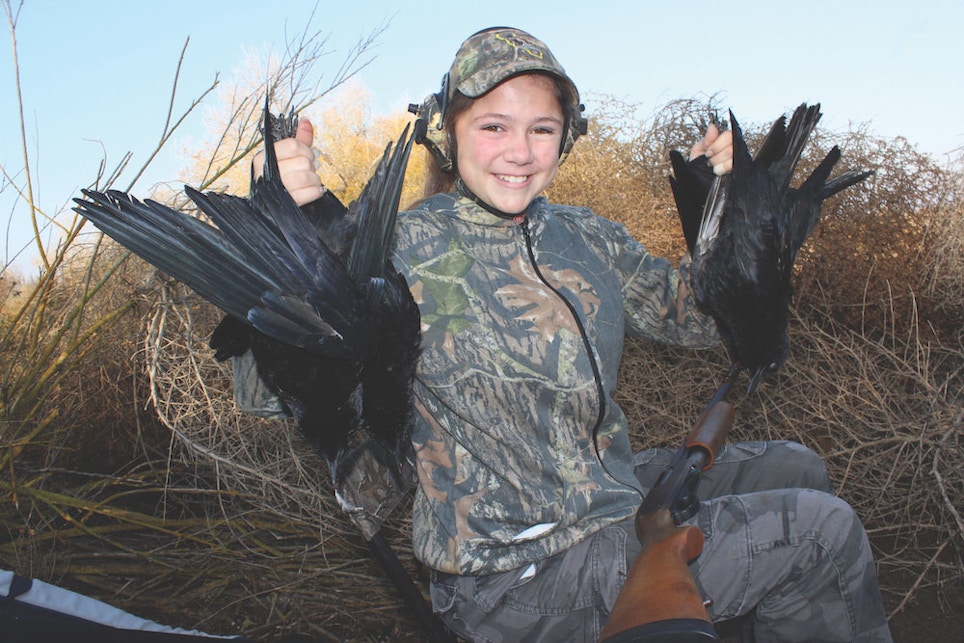I decided to dust off the black plastic decoys in late December, after the closing of the California dove season. I wanted to hunt a species I hadn’t pursued in a while — the common crow. Back in 1998, I’d stumbled on an article in an outdoor magazine on the topic and read how challenging they are to hunt and how they can be called and decoyed just like ducks. The magazine included a photo of a guy kneeling next to a dozen deceased crows, bordered by a few black plastic decoys. The article concluded with a recipe for crow meat. After investigating the season here in California and picking up a few decoys, I decided to give it a try.
Crows are smart birds with incredible eyesight. They can see color better than humans, and if they get a glimpse of anything out of the ordinary will reverse course and leave in a hurry. The glint of a shotgun barrel or the movement of a hunter is enough to ruin a setup and send them wide and out of range. A group of crows that sense human presence in an area will not likely respond to your calling. Once a group knows you’re there, they won’t come back.

Setting Up for Crows
Depending on the abundance of crows in the area I hunt, I use two different setups for calling them: a decoy-and-blind setup and running-and-gunning. Pairing a decoy setup with a blind works well if an established flyway has been identified. Crows will roost in the same general area every evening and then fly off to feed early in the morning, following a fairly regular flight pattern or flyway. If these flyways are located, setting up just off this sky path and calling can be very successful.
Frequently, when I spot crows approaching my setup and I hear them calling back, I know, at least for the time being, I have them fooled. This is the time to keep perfectly still and wait for them to close the distance.
I’ve learned that success often requires a lot more than just tossing out some decoys and making some random crow sounds. Crows make specific vocalizations in different situations and a smart hunter will learn to match these sounds with the decoy layout when he calls. A group of feeding crow decoys should be matched with crow gathering sounds. If you call and simulate crows in distress and your decoy setup says something different, they’ll realize something isn’t right and never come close.
When using a crow fighting or a crow-in-distress setup, I use an owl decoy. Crows don’t get along with great horned owls and will dive bomb and harass them when they’re encountered. Incorporating an owl decoy along with crow distress sounds will catch the attention of any nearby crows. Running-and-gunning is a method I use if I don’t have a solid understanding of the crow flyway, if the crow population is spread out or already off the roost. I’ll drive around and look for quality feeding habitat and set up near these hotspots. If I can locate an open area where decoys can be put down easily, I’ll use them. But for the most part I’m calling quickly and moving frequently. The idea here is to locate small groups, call them in, take a few and then move on. This method can be very successful if you’re hunting a new area and you aren’t familiar with the flyway.

The Right Gear
There’s no shortage of mouth-blown crow calls on the market, and most of the remote-operated electronic callers have a diverse set of digital crow sounds, from feeding and gathering crows to crows in distress. As far as volume, crows are loud birds, so when I use a mouth call, I blow on it aggressively to produce the loudest sound I can. To avoid being seen when using a mouth call, I’ll stop calling when birds get close and rely on the decoys to pull them in. When I use an electronic caller, I keep it running at the highest volume the entire time.
Crows are big birds. Even though regular dove loads in sizes No. 7½ and No. 8 can be used, high-base shells in sizes No. 4 and No. 6 will extend your range and kill more birds by delivering more energy. Hunting a bird that has incredible eyesight requires the use of camo from head to toe. Once you have your blind set up, walk out and look back at it to see if anything appears out of place. Look for unnatural colors or patterns that catch your eye, or anything shiny that would easily alarm incoming birds. Your entire blind area should look well-hidden and natural.
On a recent hunt I noticed approaching birds were responding, but once they got close they’d turn around and leave. I walked out, looked back toward the blind and saw the shining faces of both my daughters peaking over the vegetation. They looked like two bright headlights beaming over the brush. The crows were responding to the call and the decoys but spotting the bright faces of the girls and leaving. We broke out face masks and were soon dropping birds.
I took my daughter Alyssa out to see if we could call in some birds during the December crow opener. We had seen plenty of crows flying in a fairly predictable pattern near our hunting area during our dove hunting trips. We set up at the base of a row of trees and built a makeshift blind. I placed the decoys out in front in a gathering/feeding pattern, positioned my electronic caller out near the decoys and we got ready. Five minutes into the hunt, Alyssa spotted a pair of crows way out to our left. I turned on the caller and within seconds they changed course and headed our way. We stayed still and watched them as they dropped in altitude. When they spotted the decoys, they began to call almost in unison to the electronic caller. When they got close, we stood quickly and dropped the pair. The first shots of the crow season and we had a double!
A few weeks after opening day, I took my buddy Jose De Orta and his son Adrian out to see if we could call in some crows. I brought both of my daughters and the goal of the day was to see if we could get the kids on some birds. The crows weren’t moving much, and I knew we had to change things up. We started our day with limited luck using a decoy and blind setup, so we decided to run and gun.
We were hunting around almond orchards and grape vineyards — great habitat for attracting and holding crows. I’d drive the almost-endless orchard roads to find a good open spot where the kids could shoot, hiding the truck amongst the trees. Jose and I set up the kids in a safe area, made sure they stayed still and started calling. We didn’t have to wait long. Responding crows will often call back before you see them. They’ll approach the area looking for the source of the sound and circle to get a better view. If they’re fooled and don’t detect any danger, they’ll usually drop in altitude, presenting hidden hunters with a shot. Once the shots go off, crows in the general area will be aware of the danger and stop responding, making it necessary to pick up and move on. We hunted about eight different feeding habitat areas over the course of the day and did well. We ended up calling crows in at every location and all three kids dropped birds during our run-and-gun hunt.
Read the Regulations
Crow season in California runs from December 6 through April 8. The daily bag limit is 24 crows per hunter, which illustrates their statewide abundance. It should be noted that ravens — a larger, black corvidae species that looks very similar to the crow — will respond to crow calls. Both birds occupy similar habitat, but only crows can be hunted in California. Ravens are substantially larger than crows, but the easiest way to tell the two species apart in flight is the tail. The terminal end of the crow’s tail is straight across. The raven’s tail is more pointed and arrow-like. It’s essential that you are able to tell the difference between the two species before you head out for a hunt. Extend your hunting season by chasing crows. It’s challenging, relatively easy and most areas hold a substantial abundance of the birds. Once you hear them cawing in response to your calling, you’ll be hooked.






